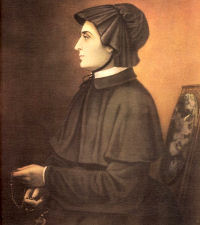» Enjoy our Liturgical Seasons series of e-books!
Born in New York, Elizabeth Seton married and became a mother of five children. After her husband's death, she converted to Catholicism and founded the American Sisters of Charity, a community of teaching sisters which began Catholic schools throughout the United States, especially helping with the education of underprivileged children. Mother Seton laid the foundation of the American parochial school system and was the first native-born American to be canonized.
![]()
St. Elizabeth Ann Seton
This wife, mother and foundress of a religious congregation was born Elizabeth Ann Bayley on August 28, 1774 in New York City, the daughter of an eminent physician and professor at what is now Columbia University. Brought up as an Episcopalian, she received an excellent education, and from her early years she manifested an unusual concern for the poor.
In 1794 Elizabeth married William Seton, with whom she had five children. The loss of their fortune so affected William's health that in 1803 Elizabeth and William went to stay with Catholic friends at Livorno, Italy. William died six weeks after their arrival, and when Elizabeth returned to New York City some six months later, she was already a convinced Catholic. She met with stern opposition from her Episcopalian friends but was received into full communion with the Catholic Church on March 4, 1805.
 Abandoned by her friends and relatives, Elizabeth was invited by the superior of the Sulpicians in Baltimore to found a school for girls in that city. The school prospered, and eventually the Sulpician superior, with the approval of Bishop Carroll, gave Elizabeth and her assistants a rule of life. They were also permitted to make religious profession and to wear a religious habit.
Abandoned by her friends and relatives, Elizabeth was invited by the superior of the Sulpicians in Baltimore to found a school for girls in that city. The school prospered, and eventually the Sulpician superior, with the approval of Bishop Carroll, gave Elizabeth and her assistants a rule of life. They were also permitted to make religious profession and to wear a religious habit.
In 1809 Elizabeth moved her young community to Emmitsburg, Maryland, where she adopted as a rule of life an adaptation of the rule observed by the Sisters of Charity, founded by St. Vincent de Paul. Although she did not neglect the ministry to the poor, and especially to Negroes, she actually laid the foundation for what became the American parochial school system. She trained teachers and prepared textbooks for use in the schools; she also opened orphanages in Philadelphia and New York City.
She died at Emmitsburg on January 4, 1821, was beatified by Pope St. John XXIII in 1963, and was canonized by Pope St. Paul VI in 1975.
—Excerpted from Saints of the Roman Calendar by Enzo Lodi
Patronage: against the death of children; against in-law problems; against the loss of parents; Apostleship of the Sea; opposition of Church authorities; people ridiculed for their piety; Diocese of Shreveport, Louisiana; widows
Highlights and Things to Do:
- Meditate on these words of St. Elizabeth Ann Seton, "What was the first rule of our dear Savior's life? You know it was to do His Father's will. Well, then, the first end I propose in our daily work is to do the will of God; secondly to do it in the manner He wills; and thirdly, to do it because it is His willl. I know what is His will by those who direct me; whatever they bid me do, if it is ever so small in itself, is the will of God for me. Then, do it in the manner He wills it."
- Pray this beautiful prayer of St. Elizabeth Ann Seton daily: Oh Father, the first rule our dear Savior’s life was to do Your Will. Let His Will of the present moment be the first rule of our daily life and work, with no other desire but for its most full and complete accomplishment. Help us to follow it faithfully, so that doing what You wish, we will be pleasing to You. Amen.
- Read more about St. Elizabeth Ann Seton:
- See Catholic Cuisine for some food ideas for her feast day.
- Visit in person or online the National Shrine of Elizabeth Seton in Emmitsburg, Maryland, which is where she is buried.
- Nearby is also the National Grotto of Our Lady of Lourdes, where St. Elizabeth prayed.






